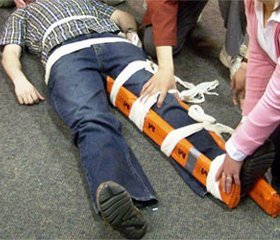Журнал «Травма» Том 16, №3, 2015
Вернуться к номеру
Treatment of long bones fractures of victims due to traffic accident
Авторы: Guryev S.O., Satsyk S.P., Yevdoshenko V.P., Natsevych R.O. - State Institution «Ukrainian scientific and practical center of emergency medical care and disaster medicine of Ministry of Healthcare of Ukraine», Kyiv, Ukraine
Рубрики: Травматология и ортопедия
Разделы: Справочник специалиста
Версия для печати
fracture, long bones, traffic accident, treatment, protocol.
Introduction. The problem of the treatment of victims with long bones fractures was and remains relevant currently, particularly in victims with combined injuries. Lack of optimal treatment strategy, the use of outdated technologies of diagnosis and treatment, not certainty the timing and volume of surgical interventions do not help improve the results of treatment victims with polytrauma with long bones fractures.
Materials and methods. We analyzed data of treatment of 228 victims with polytrauma due to traffic accidents with long bones fractures. Depending on the treatment strategy of damages the victims were divided into two groups. The main group included 89 victims with polytrauma due to traffic accidents who damaged 163 long bones. In this group, the treatment of fractures followed tactics Damage Control Orthopaedic and acceptance protocol we developed of clinical and organizational performance solutions for surgery to correct damage of long bones in victims with polytrauma due to traffic accidents. The comparing group included 139 victims with polytrauma due to traffic accidents who damaged 255 long bones.
In this group, the treatment of fractures followed traditional treatments of victims without evaluating the severity of injuries and without evaluating severity of the condition. Methods of treatment of long bone fractures were the same as in the main group.
Results. In the main group during the first day after receiving, surgery fully implemented for correction 37 (22.7%) fractures of long bones, including plate osteosynthesis - 23 (14.1%), blocking intramedullary osteosynthesis without reaming marrowy channel (BIOS) - 14 (8.6%). External fixation device (EFD) was used in 66 (40.5%) cases of fractures, of which 30 (18.4%) cases EFD stayed final osteosynthesis, and the rest 36 (22.1) cases had been replaced retainer. The final reconstructive surgery and replacement EFD performed after 14-21 days by internal retainers. BIOS after skeletal traction / immobilization plaster performed in 17 (10.4%) cases after EFD - 21 (12.9%). Plate osteosynthesis after skeletal traction / immobilization plaster performed in 37 (22.7%) cases after EFD - 15 (9.2%). In the main group BIOS used in 31 (19%) fractures of long bones, plate osteosynthesis - 60 (36,8%), EFD, as the final method of osteosynthesis - 30 (18.4%). That is surgery on long bones fractures performed in 121 (74.2%) cases. Mortality in the group was 11 (12.4%) cases.
In the comparing group during the first day after receiving, surgery fully implemented for correction 81 (31.8%) fractures of long bones, including plate osteosynthesis - 18 (7.1%), BIOS - 9 (3.5%). EFD was used in 57 (22.4%) cases of fractures, of which 45 (17.7%) cases EFD stayed final osteosynthesis, and the rest 12 (4.7) cases had been replaced retainer. The final reconstructive surgery and replacement EFD performed after stabilization of the victim after 2-21 days by internal retainers. BIOS after skeletal traction / immobilization plaster performed in 40 (15.7%) cases after EFD - 4 (1.6%). Plate osteosynthesis after skeletal traction / immobilization plaster performed in 75 (29.4%) cases after EFD - 8 (3.1%). In the comparing group BIOS used in 49 (19.2%) fractures of long bones, plate osteosynthesis - 93 (36,5%), EFD, as the final method of osteosynthesis - 45 (17.7%). That is surgery on long bones fractures performed in 187 (73.3%) cases. Mortality in the group was 23 (16.5%) cases.
Conclusions.
1. Selection osteosynthesis of long bone fractures of victims due to traffic accidents depends on the severity of injuries, the severity condition of the victims, the nature and location of the fracture, the degree of damage to the soft tissues.
2. To improve the results of treatment victims with long bones fractures need more application of modern technologies treatment and standardized protocol of treatment schemes and protocols of clinical and organizational decision.
3. Application protocol we developed of clinical and organizational performance solutions for surgery to correct damage of long bones in victims with polytrauma due to traffic accidents. allows to increase survival level of victims from 83.5% to 87.6%.

